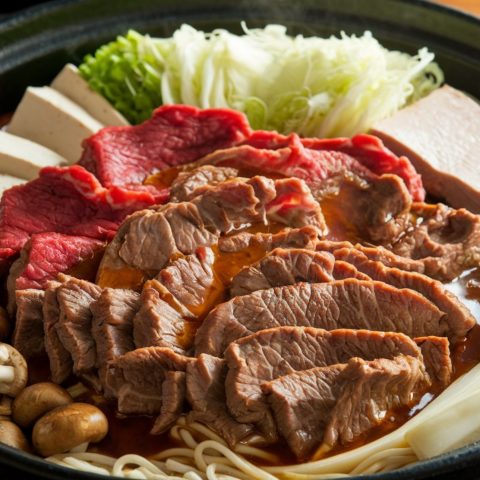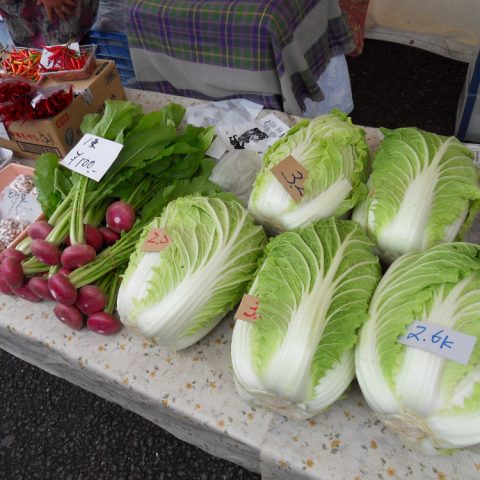
Known for its stunning mountain scenery, amazing winter sports, and the famous hot spring loving snow monkeys, is Nagano Prefecture (長野県). Located in the middle of Honshu, Nagano is the largest landlocked prefecture in Japan, bordering 8 other prefectures. Nagano City is the capital city, with other notable areas including Matsumoto where Matsumoto castle is located, and Yamanouchi famous for its onsens and home to the snow monkeys. As one of the most mountainous prefectures in Japan, with no direct access to the ocean, and a cold climate, the food in Nagano is quite unique.
So, let’s look at 5 of the most popular foods in Nagano!

Photo credit: clvs7 on Flickr
Shinshu Soba (信州そば)
With the ideal climate to cultivate buckwheat, it’s no surprise that Nagano is famous for its Shinshu soba. Nagano’s steep mountainous terrain and cold climate make it difficult to grow rice, so the prefecture instead focused on producing buckwheat that thrives in these types of areas. Shinshu soba is the name given to buckwheat noodles made in Nagano, with Shinshu (also known as Shinano Province) being the old name for the prefecture.
Compared to other types of soba, Shinshu soba noodles are slightly thicker, giving every bite a satisfying chewiness, with a subtle nutty flavour. There are many ways to enjoy soba, from zaru soba where cold noodles are served with a tsuyu dipping sauce, to kake soba where noodles are served in a warm broth, just to name a couple. If you’d like to try a delicious, healthy, authentic Nagano dish, make sure to try Shinshu soba next time you’re in the prefecture!

Photo credit: buri on PhotoAC
Oyaki (おやき)
Oyaki is the perfect dish for anyone who wants to enjoy a delicious veggie-filled snack. With a long history, dating back to the Jomon Period in Northern Nagano, oyaki are stuffed dumplings that can be found all over the prefecture.
These dumplings are made by kneading buckwheat flour, wheat flour, and water together to create a chewy dough, with a wide variety of fillings. Oyaki are typically made with vegetarian ingredients, focusing on seasonal vegetables. Some of the most popular fillings include nozawana, anko, mushrooms, mashed pumpkin, and apple just to name a few. Traditionally, these dumplings were cooked in the ash of an open fire in an irori, however, nowadays oyaki are usually fried before being steamed. Since oyaki only cost about 200 yen each, they are a very affordable snack to enjoy while exploring Nagano!

Photo credit: Yusuke Kawasaki on Flickr
Gohei Mochi (五平餅)
If you’re looking for something sweet, then why not try Nagano’s flavourful Gohei mochi. Mochi is one of the most famous Japanese desserts, with many prefectures having their own specialty. Gohei mochi is a popular snack in Nagano, Gifu, and Aichi prefectures, however it originated in Nagano during the Edo Period.
Sticky dough made from pounded rice is added to a wooden or flat bamboo skewer and then coated with a thick, sweet sauce before being grilled over a fire. The sugary sauce is usually made with a base of either miso or soy sauce, and for a delicious crunch, sesame seeds, walnuts, or peanuts may be added. Typically, Gohei mochi is either a flat oval shape like a traditional Japanese sandal, or smaller balls of mochi on a skewer similar to dango.
Did you know that even within Nagano, the appearance, flavour, and skewers used in Gohei mochi can change depending on the region? So make sure to try some of the different types of Gohei mochi available across the prefecture.

Photo credit: mint*camera on PhotoAC
Gyunyu pan (牛乳パン)
Although it might seem simple, gyunyu pan is a sweet treat that should not be overlooked. Gyunyu pan, which directly translates as milk bread, is a popular dessert that can be found at many bakeries throughout Nagano. Although the exact origins of this bread are unclear, it is believed that gyunyu pan was first made during the Showa Period, when milk consumption was increasing across Japan.
This delectable dessert consists of soft fluffy bread, made by kneading milk into the dough, with a sweet cream filling. The gyunyu pan packaging is very distinctive, with a blue and white retro design typically featuring a cow and/or person, although it does vary depending on where the bread is made.
If you have a sweet tooth, make sure to try gyunyu pan while you’re in Nagano, since you might not be able to find it elsewhere!

Photo credit: sixcube on PhotoAC
Mountain Vegetables
As a landlocked prefecture with mountainous terrain, you can’t talk about the food in Nagano without mentioning mountain vegetables. Commonly called sansai (山菜) in Japan, these edible wild plants that grow in the mountains are packed with flavour and make a delicious addition to any meal. Spring is the best season to enjoy fresh mountain vegetables, since many local shops will sell the vegetables and restaurants will serve dishes made with them.
The must-try mountain vegetable in Nagano is nozawana. Nozawana is a leafy green in the common turnip family that is also considered a mustard leaf. Depending on how it’s cooked, nozawana has a mild peppery and slightly bitter flavour, similar to turnip, radish, or daikon leaves. Other popular mountain vegetables include kogomi (fiddlehead fern), warabi (bracken fern), fukinoto (Japanese butterbur), tara-no-me (Japanese angelica tree shoots), and koshiabura.
Since most mountain vegetables spoil quickly after being picked, the most common way to enjoy them is pickled or boiled and served as side dishes. However, these vegetables also make an excellent main meal, especially when fried in tempura.
You may be drawn to Nagano to view the beautiful scenery or partake in winter sports, but don’t forget to try some of the delicious local dishes next time you’re in the prefecture!
Feature photo credit: Sora Yamagake on Unsplash
Join our tours in Tokyo to learn about Japanese cuisine and what makes it so special!




